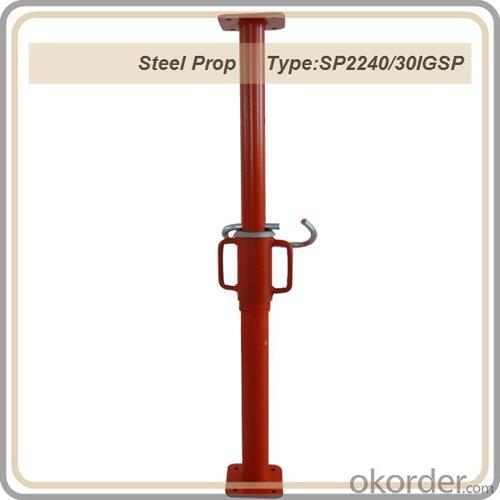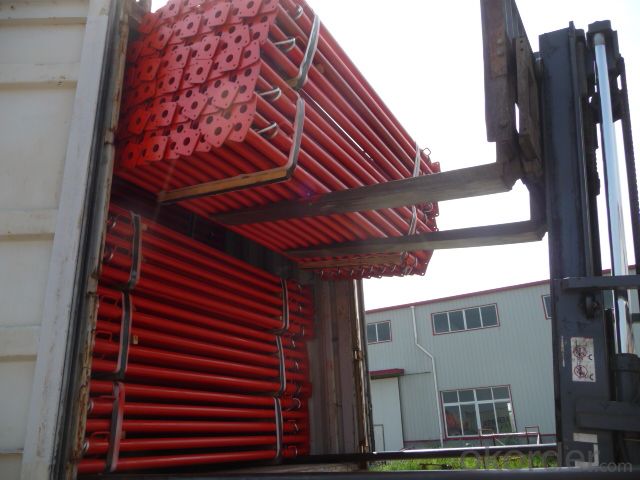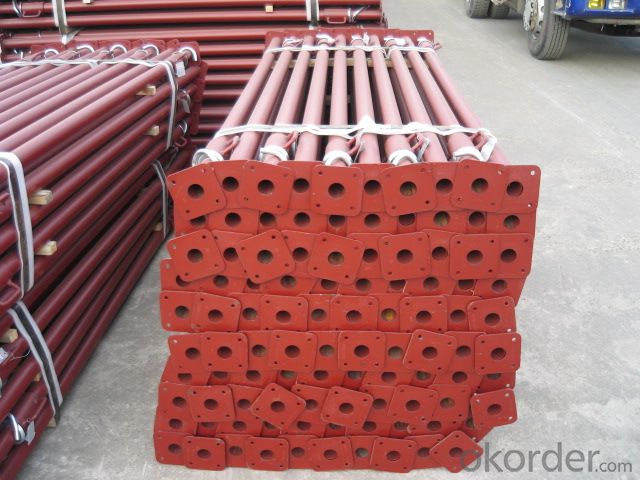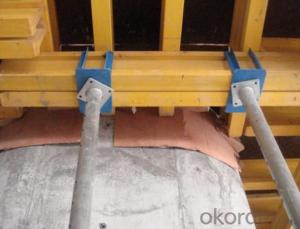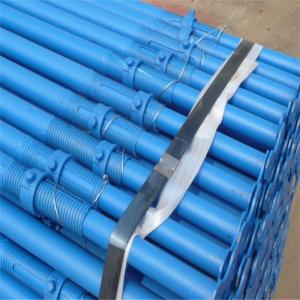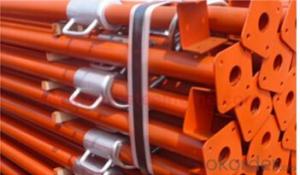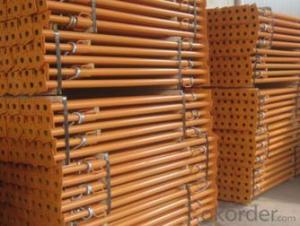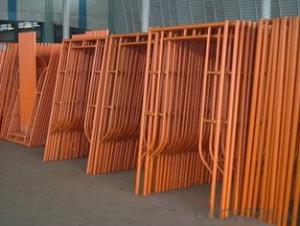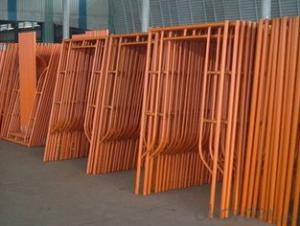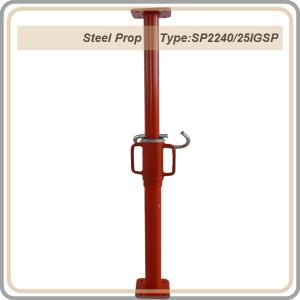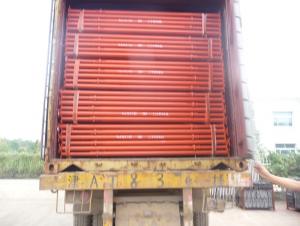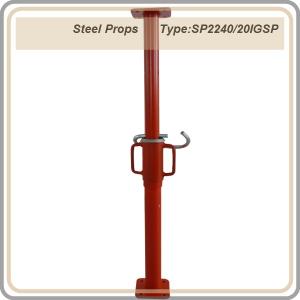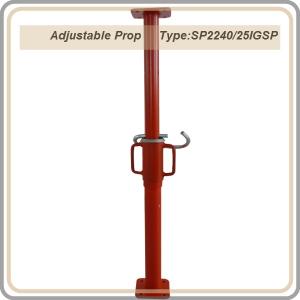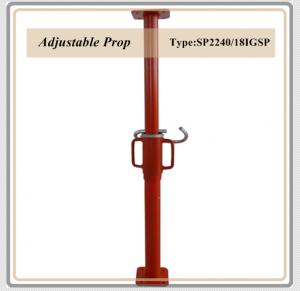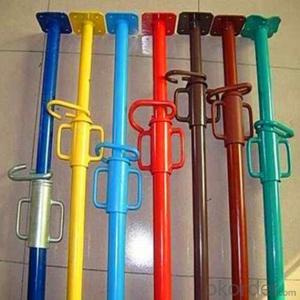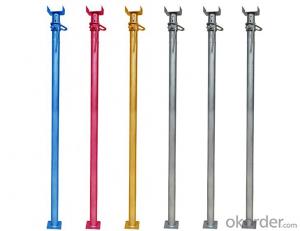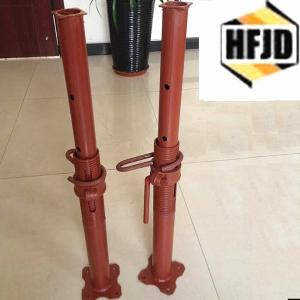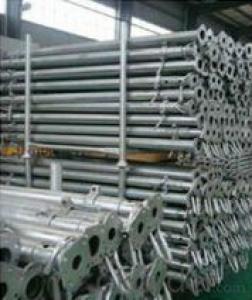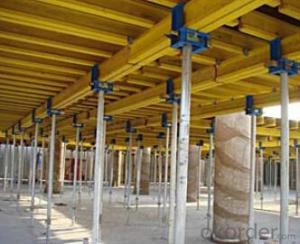Export Steel Props/red color prop 2.2-4M/thickness 3.0mm
- Loading Port:
- China Main Port
- Payment Terms:
- TT or LC
- Min Order Qty:
- 1680 Piece/Pieces 1680pcs / 20'FT container pc
- Supply Capability:
- 10000 pc/month
OKorder Service Pledge
OKorder Financial Service
You Might Also Like
1. Length 2200-4000mm
2. Outer tube diameter 56mm
3. Inner tube diameter 48mm
4. Tube material : Q235
5. Tube thickness : 3.0mm
6. weight : 16.6kgs
7. square plate : 120*120*4mm
8. Italian type nut
9. G-pin 12
10. Painted surface
11. Color : as customer 's request . red / blue / green / orange/ brown
Packaging & Delivery
| Packaging Details: | packaging :50pcs / bale container : 1680pcs / 20ft |
|---|---|
| Delivery Detail: | 20-30days after receive deposit |
Specifications
Adjustable props / construction prop
Height 2.2-4M
Italy type painted props
Adjustable props
Shoring props
Construction scaffold steel prop
Scaffold props
Telescopic steel props
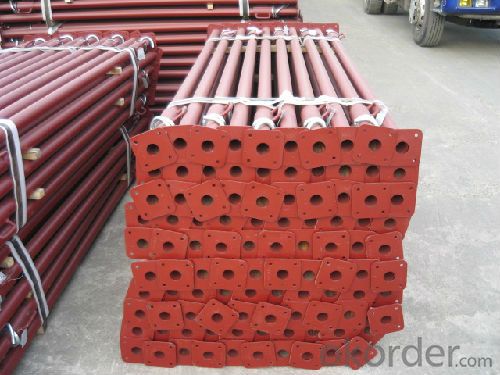
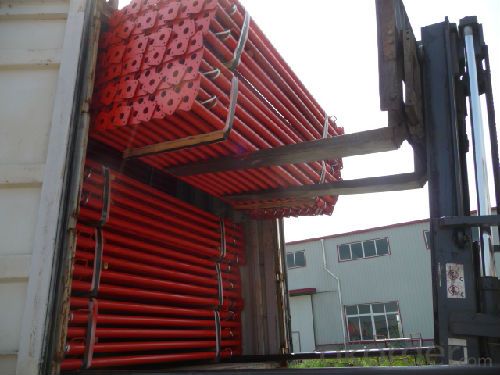
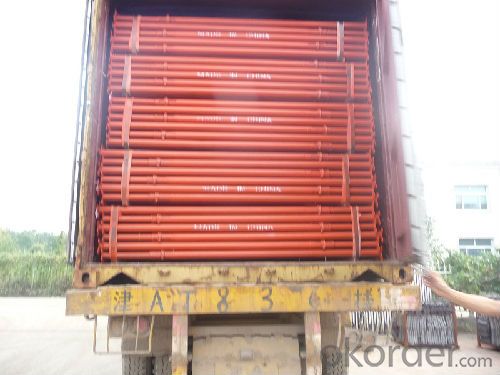
Product introduce
Steel Prop is a labour and time saving device to support shuttering and centering.
It is made outer tube of 60mm (O. D.) & inner pipe of 48mm (O. D.)
or outer tube 56mm (O.D.) & inner pipe 48mm (O.D.) ,
or outer tube 48mm (O.D.) & inner pipe 40 mm (O.D.) moving in each other telescopically.
The surface has painted , powder , electric galvanized and hot dipped galvanized .
The height use of props by double staging is recommended upto 7000mm only .
Top and bottom plate are provided with nail holes for wooden beam or steel beam .
The top has square shape , flower shape or U-head , U-fork head .
U-head can use fix or adjustable .
- Q: Can steel props be used in the construction of temporary religious or worship structures?
- Yes, steel props can be used in the construction of temporary religious or worship structures. Steel props are commonly used in construction to support and stabilize structures during the building process. They provide temporary structural support and are adjustable in height, making them suitable for various construction projects, including temporary religious or worship structures. Temporary religious or worship structures are often needed for events such as religious ceremonies, festivals, or gatherings. These structures may require quick assembly and disassembly, thus making steel props a convenient choice due to their ease of installation and removal. Steel props offer several advantages in the construction of temporary religious or worship structures. Firstly, they provide the necessary stability and support to ensure the safety of the structure and its occupants. Steel props can bear heavy loads, ensuring the structural integrity of the temporary worship space. Secondly, steel props are adjustable in height, which allows for flexibility in designing the temporary structure. This adaptability is particularly useful in accommodating different types of religious rituals or events that may require specific spatial arrangements. Additionally, steel props are durable and resistant to weather conditions, making them suitable for outdoor worship structures. They can withstand harsh weather elements, ensuring the safety and longevity of the temporary structure during its intended use. Furthermore, steel props are easily transportable and reusable, making them cost-effective for temporary structures. They can be disassembled and relocated to different locations, making them convenient for religious communities that may need to set up temporary worship spaces in various places. In conclusion, steel props can be used in the construction of temporary religious or worship structures. Their stability, adjustability, durability, and portability make them a suitable choice for supporting and ensuring the safety of these structures during events or gatherings.
- Q: Are steel props adjustable in small increments for precise leveling?
- Steel props have the ability to be adjusted in small increments, allowing for precise leveling. They are commonly used in construction projects to provide temporary support and stability to beams, walls, and ceilings. These props, also known as adjustable steel props or scaffolding props, consist of two main components - an outer tube and an inner tube. The inner tube can be adjusted to different heights, enabling the supported structure to be leveled accurately. The adjustment process involves rotating a threaded collar on the outer tube, resulting in the inner tube moving up or down in small increments. This adjustability feature makes steel props an exceptional choice for achieving exact and precise leveling in construction projects.
- Q: Are steel props adjustable for uneven ground conditions?
- Yes, steel props are adjustable for uneven ground conditions. Steel props, also known as steel acrow props or steel shore props, are designed to provide temporary support to structures during construction or renovation projects. These props consist of an outer tube, an inner tube, and a threaded screw jack mechanism that allows for height adjustment. To accommodate uneven ground conditions, steel props are equipped with a base plate that can be adjusted to different angles. This allows the prop to be securely placed on uneven surfaces such as slopes or uneven terrain. By adjusting the base plate, the prop can be leveled and stabilized, ensuring proper support for the structure. Furthermore, steel props are available in various sizes and load-bearing capacities, allowing them to be used in different applications and supporting different weights. This versatility makes them suitable for a wide range of projects, including those on uneven ground conditions. It is worth noting that while steel props provide adjustable support for uneven ground conditions, it is important to assess the stability and safety of the surrounding area. In some cases, additional measures such as shoring or ground stabilization techniques may be required to ensure the safety of the structure and personnel working on the site.
- Q: Can steel props be used for supporting temporary lighting systems?
- Temporary lighting systems can be supported using steel props. These props, also referred to as adjustable steel props or steel acrow props, are commonly utilized in construction and temporary support scenarios. Their purpose is to offer stability and load-bearing capacity, making them an excellent choice for supporting different structures, including temporary lighting systems. One advantage of steel props is their adjustable height feature, which allows for easy customization to meet the specific requirements of the lighting system. By securely holding the weight of the lighting fixtures, they provide a stable foundation for installation. Furthermore, steel props are renowned for their durability and strength, ensuring the safety of the lighting system and preventing accidents or damage caused by insufficient support. In addition, steel props can be easily installed, dismantled, and transported, making them highly convenient for temporary lighting systems that need to be quickly set up and taken down. Their easy adjustability and positioning capabilities guarantee proper support for the lighting system, ensuring adequate illumination and functionality. In conclusion, steel props are a trustworthy and efficient solution for supporting temporary lighting systems. They possess the necessary strength, stability, and adjustability required for securely mounting and supporting lighting fixtures in various temporary applications, such as events, construction sites, or temporary installations.
- Q: Steel braced steel purlin and anchor beam waist connection
- Disclaimer: about the steel braced steel purlin and anchor beam waist connection should be clear in the construction scheme, construction technology scheme. In order to ensure the safety, the force and the state of the joint shall be determined by calculation, including the diameter of the anchor cable, the material requirements and the safety factor, the welding seam height, etc.. After the establishment of the technical scheme, the technical department should be organized to discuss the special measures to ensure the safe operation of the project, and it should be implemented in accordance with the procedure. Reiterate: before the construction of a variety of resources are fully prepared, the construction should adhere to safety first.
- Q: Are steel props suitable for supporting formwork systems?
- Yes, steel props are suitable for supporting formwork systems. Steel props are commonly used in construction projects to provide temporary support to formwork systems during the concrete pouring process. They are adjustable in height, which allows for flexibility in accommodating different formwork heights and load requirements. Steel props are strong, durable, and capable of withstanding heavy loads, making them a reliable choice for supporting formwork systems. Additionally, steel props are easy to assemble and dismantle, making them convenient to use on construction sites. Overall, steel props are considered a suitable option for providing support to formwork systems in construction projects.
- Q: How are steel props adjusted for different heights?
- Steel props, also known as adjustable steel props or acrow props, are commonly used in construction to support temporary structures or to provide additional support to existing structures. These props are adjustable in height to accommodate different requirements. The adjustment of steel props for different heights is a relatively simple process. Each prop consists of an outer tube and an inner tube, with a threaded collar or pin mechanism allowing for height adjustment. To adjust the prop to a desired height, the outer tube is extended or retracted by rotating it in a clockwise or counterclockwise direction. This rotation causes the threaded collar or pin mechanism to engage with the inner tube, either locking it in place or allowing it to move freely. Once the desired height is reached, the prop is secured by tightening a locking mechanism, such as a collar or pin, to prevent any further movement. This ensures that the prop remains stable and provides the necessary support. In some cases, steel props may have additional features like telescopic sections or adjustable base plates to further enhance their adjustability and stability. These features allow for fine-tuning of the height and provide flexibility in adapting to various construction requirements. Overall, the adjustment of steel props for different heights is a straightforward process involving the extension or retraction of the outer tube and securing it in place with a locking mechanism. This adjustability makes steel props a versatile and widely used tool in the construction industry.
- Q: Are steel props suitable for supporting concrete slabs?
- Concrete slabs can be adequately supported by steel props. Steel props, also called adjustable steel props or acrow props, are frequently utilized in construction to temporarily provide support for concrete slabs during construction or remodeling. They are designed to adjust in height and can be easily installed and removed. Steel props are manufactured from high-quality steel, which gives them strength and durability. This allows them to bear the weight of concrete slabs and other construction materials. They have the ability to support the load and evenly distribute it, ensuring the stability of the concrete slab. Moreover, steel props offer flexibility in terms of height adjustment. Their telescopic design allows for effortless extension and retraction, making them suitable for supporting concrete slabs of various thicknesses. The ability to adjust their height also allows construction workers to effortlessly level the slabs and achieve a smooth and even surface. Aside from their strength and adjustability, steel props are also easy to handle and transport. They are lightweight and can be easily maneuvered around the construction site, making them a convenient choice for supporting concrete slabs in different areas. In summary, steel props are a suitable and reliable option for supporting concrete slabs. Their strength, adjustability, and ease of use have made them a popular choice in the construction industry.
- Q: How do you prevent accidents or injuries while using steel props?
- In order to prevent accidents or injuries when using steel props, it is important to adhere to several important measures: 1. Training and knowledge: Prior to handling steel props, it is crucial to receive proper training in their use. Take the time to familiarize yourself with the manufacturer's instructions, safety guidelines, and any specific precautions that must be taken. 2. Regular inspections: Before utilizing steel props, thoroughly inspect them for any indications of damage, such as cracks, bends, or excessive wear. If any issues are discovered, promptly repair or replace them to guarantee their effectiveness and safety. 3. Proper handling and storage: When handling steel props, make sure to utilize appropriate lifting techniques and avoid overloading them beyond their designated capacity. Additionally, store them securely in a safe location to prevent accidental damage or knocking them over. 4. Secure placement: To prevent shifting or collapse during use, ensure that steel props are positioned and anchored properly. Follow the manufacturer's guidelines for correct placement and confirm that the supporting surface is stable and capable of bearing the load. 5. Clear communication and coordination: If multiple workers are involved in the use of steel props, clear communication and coordination are vital. Establish a system of signals or verbal communication to ensure that everyone is aware of the activities being performed and can take necessary precautions. 6. Personal protective equipment (PPE): Always wear the appropriate personal protective equipment, such as safety gloves, goggles, and steel-toed boots, when handling steel props. This will provide protection against potential accidents or injuries resulting from sharp edges, falling debris, or other hazards. 7. Regular maintenance: Regularly maintain steel props by cleaning, lubricating, and inspecting them to ensure optimal performance and longevity. Promptly replace any damaged or worn-out parts. 8. Risk assessment: Before using steel props, conduct a thorough risk assessment to identify potential hazards and implement suitable control measures. Consider factors such as the load being supported, environmental conditions, and the presence of other workers or equipment nearby. By adhering to these preventive measures, individuals can significantly minimize the risk of accidents or injuries when using steel props, resulting in a safer working environment for everyone involved.
- Q: Can steel props be used for supporting temporary religious structures?
- Yes, steel props can be used for supporting temporary religious structures. Steel props, also known as adjustable steel props or acrow props, are commonly used in construction and temporary structures to provide support and stability. They are versatile and can be easily adjusted to the required height, making them suitable for various types of structures, including temporary religious structures. Steel props are strong and durable, capable of withstanding heavy loads and providing structural support. They have a wide base and adjustable top plate, allowing them to be securely fixed to the ground and provide stability to the structure they support. This makes them ideal for temporary religious structures, such as tents or temporary chapels, which need to be strong and stable to ensure the safety of worshippers. Moreover, steel props are easy to install and dismantle, making them a practical choice for temporary structures that may need to be set up and taken down quickly. They can be used to support the roof or walls of the structure, ensuring its stability and integrity. Overall, steel props are a reliable and versatile choice for supporting temporary religious structures. They offer strength, stability, and ease of installation, making them a practical solution for ensuring the safety and stability of such structures.
Send your message to us
Export Steel Props/red color prop 2.2-4M/thickness 3.0mm
- Loading Port:
- China Main Port
- Payment Terms:
- TT or LC
- Min Order Qty:
- 1680 Piece/Pieces 1680pcs / 20'FT container pc
- Supply Capability:
- 10000 pc/month
OKorder Service Pledge
OKorder Financial Service
Similar products
Hot products
Hot Searches
Related keywords




